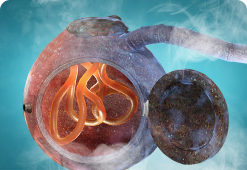Blood in urine (haematuria)
Haematuria may cause your urine to appear pink, tea- or cola-coloured because it contains traces of blood, however, the traces aren’t always visible to the naked eye.1 It may occur during a cold, sore throat, or other respiratory infections, or soon after.1,4
Watch this animation to learn more about why you get blood in your urine.
Foamy urine (proteinuria)
Healthy kidneys keep most proteins in the blood from leaking into the urine.1 However, when the glomeruli are damaged, protein leaks out of the blood which makes urine look foamy.3
Swelling (oedema)
Damaged glomeruli disrupt the healthy absorption of fluid in the body.1 This can cause swelling (oedema), usually in the lower body and sometimes the hands or face.1
Pain
Some people with IgAN experience pain in the sides of their body where their kidneys are located.3 This part of the body is also called the flank.5 Others may experience so much swelling that it becomes painful.6
High blood pressure (hypertension)
IgAN can also increase your blood pressure.3 This can happen due to kidney damage, and a build-up of waste products and excess fluid in the bloodstream.3 This is an important concern because hypertension increases the risk of strokes and cardiovascular disease.7
How do symptoms progress over time?
Some patients may develop kidney failure after about 10 to 20 years of having IgAN.1 Kidney failure means that a person’s kidneys no longer work as well as they should.1,8 People with kidney failure might experience:1,8
- Little or no urination
- Fatigue
- Drowsiness
- Itching
- Numbness
- Dry skin
- Headaches
- Weight loss
- Loss of appetite
- Nausea and vomiting
- Difficulty sleeping
- Difficulty concentrating
- Darkened skin
- Muscle cramps
Patients with kidney failure sometimes need dialysis.8 This is where a machine outside of your body filters your blood for you.1 If your kidney function is very low, a kidney transplant might also be an option.8
You should always check with your doctor if you are experiencing new symptoms, or your current symptoms are getting worse. You can track your symptoms and find advice to help you get the most out of your interactions with your doctor here.

About IgA nephropathy
Watch to learn more about your condition.

Living with IgAN
Learn how you can empower yourself to live as well as possible.

Diet with IgAN
Find out how diet may help maintain kidney function.

IgAN and mental health
However you might be feeling, you’re not alone. Find support here.